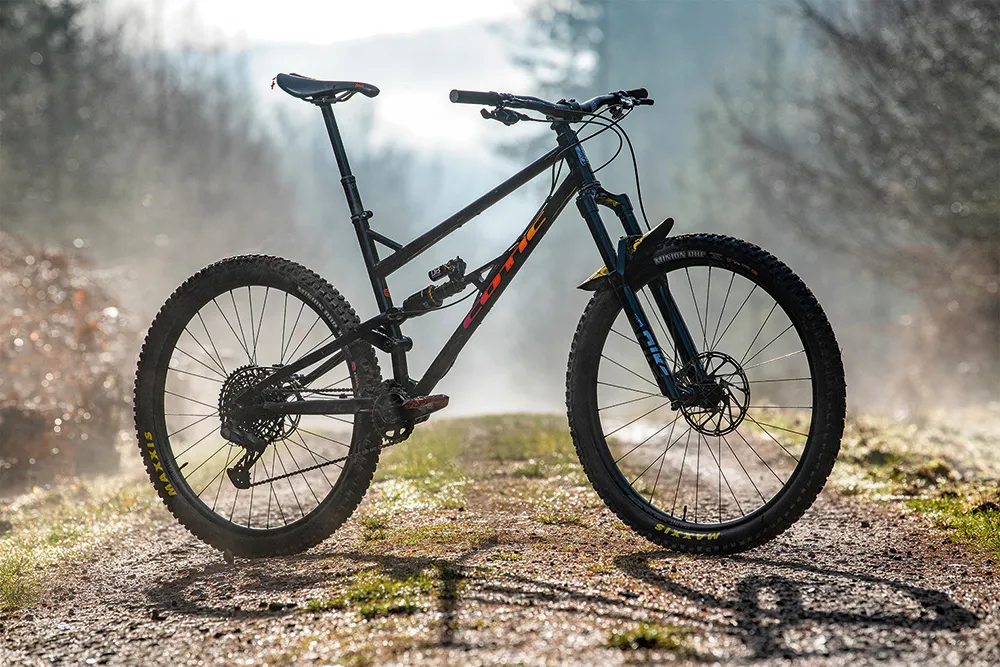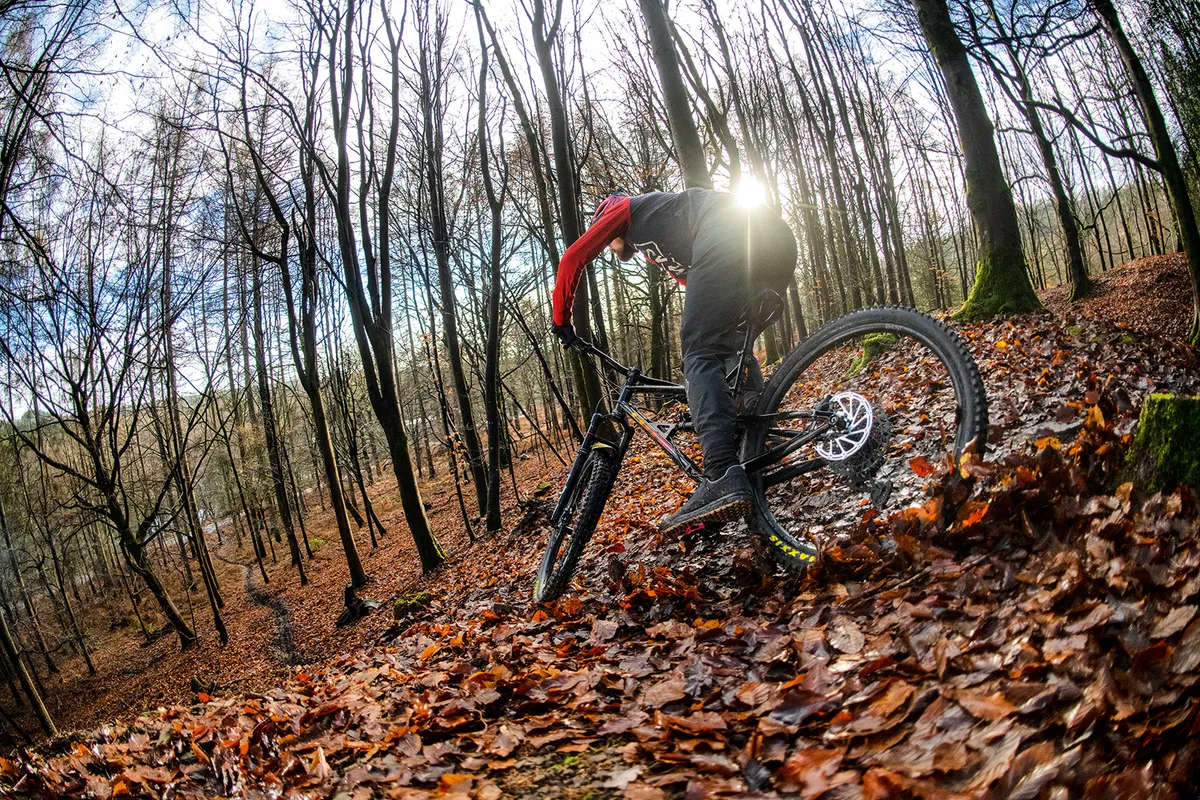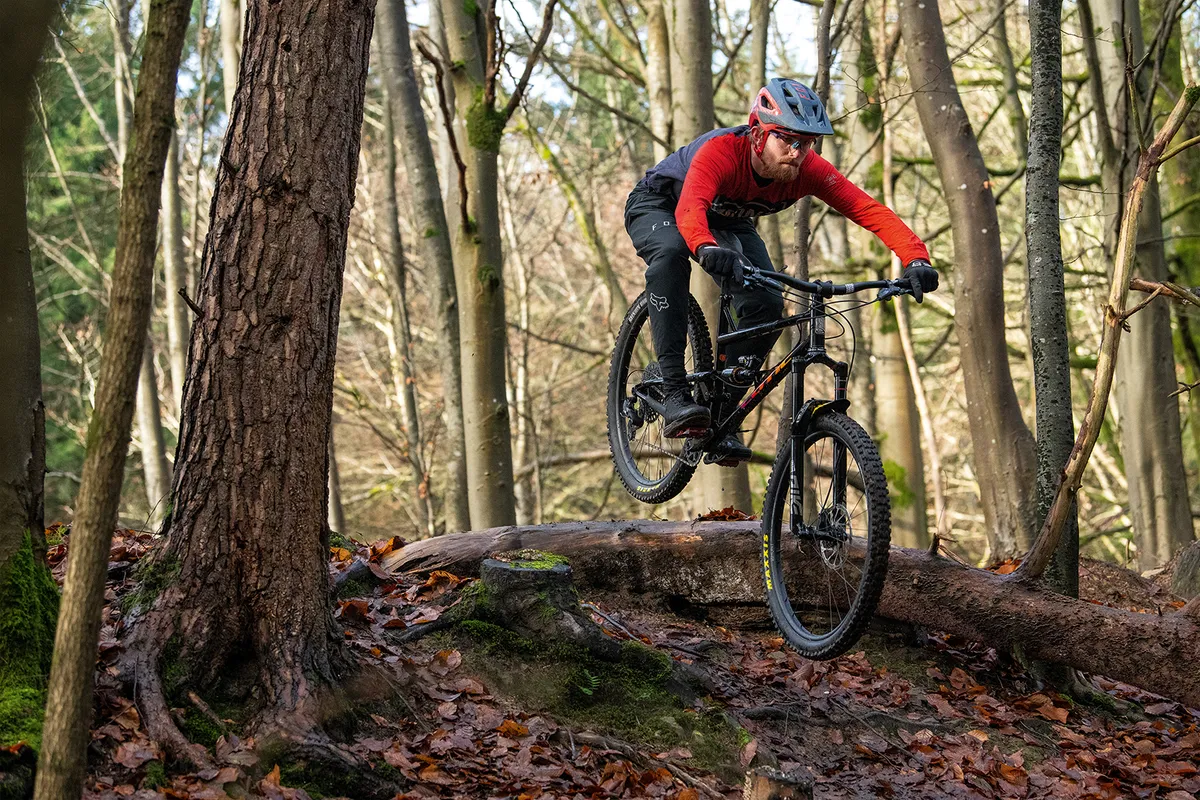The Jeht is the latest from Sheffield-based Cotic. With 29in wheels, 140mm of rear-wheel travel and a 150mm fork, it fits neatly in between its FlareMAX (120mm) and RocketMAX (160mm).
According to Cotic, it’s the best all-rounder in the range. The launch edition bike I have here is made in the UK at Cotic HQ, but most frames will be produced in Taiwan. This may be less appealing to some, but it drops £300 off the price (although EU customers will still have to pay the tariff, handling fee and VAT of their country).
Cotic Jeht Gold GX frame and geometry
Cotic uses custom tubing from Reynolds, including an ovalised top tube and 35mm seat tube to improve stiffness. The swingarm is made from aluminium because it’s stiffer, lighter and easier to manufacture.
Bottle cage bosses hang underneath the top tube, so the bike can carry water with the right cage. Cable routing is external, apart from the gear cable, which goes through the swingarm.

Frustratingly, all cables run through the forward shock mount, which is enclosed on the XL size, making it impossible to remove the brake without disconnecting the hose.
On smaller sizes, the hose can be removed after unbolting the shock. The single-pivot rear end drives the shock via a link attached to the seatstay, which adds progression throughout the stroke.
| | S | M | L | XL |
|---|---|---|---|---|
| Seat angle (degrees) - at 815mm BB-saddle height | 75.5 | 75.5 | 75.5 | 75.5 |
| Head angle (degrees) | 64.5 | 64.5 | 64.5 | 64.5 |
| Chainstay (cm) | 44.7 | 44.7 | 44.7 | 44.7 |
| Seat tube (cm) | 39 | 42.5 | 46 | 49.5 |
| Top tube (cm) | 59.5 | 62.1 | 64.7 | 67.4 |
| Head tube (cm) | 10 | 11 | 12 | 13 |
| Bottom bracket drop (cm) | 2.7 | 2.7 | 2.7 | 2.7 |
| Wheelbase (mm) | 1,228.50 | 1,255.80 | 1,283.10 | 1,312.50 |
| Stack (cm) | 61.6 | 62.5 | 63.4 | 64.3 |
| Reach (cm) | 44.4 | 46.7 | 49 | 51.5 |
Cotic Jeht Gold GX kit
Customisation is easy, with Cotic offering a range of components that can be swapped or upgraded. You can even send Cotic your own gear, from your favourite saddle to a whole suite of parts, for the team to build your bike with.
My test bike had several upgrades, including SRAM G2 RSC brakes (which were disappointingly underpowered, so I’d suggest sticking with the standard Shimano XT four-pots), Cane Creek’s highly adjustable DB Kitsuma air shock and Maxxis tyres.
It also had a RockShox Pike Ultimate fork, which is a no-cost swap from a Cane Creek Helm. While I’d rather have a burlier RockShox Lyrik or Fox 36, the Pike is certainly easier to set up than the Helm.
Cotic Jeht Gold GX ride impressions
I measured the Jeht’s effective seat-tube angle at 74.4 degrees at my pedalling height (with the saddle 830mm from the bottom bracket). That made it the slackest I had on test, although only by a small margin.
Add that to the suspension, which lacks anti-squat and so bobs and wallows more than most under power, and the result is a lazy feel on the climbs, even when compared to the heavier Starling Murmur.

In tight turns, the front end feels a little far away because the seated position is too rearward, making it difficult to keep the front wheel properly weighted on steep climbs without straining.
And while weight (15.4kg) isn’t the primary problem, there isn’t a lot you could cheaply do to make this build much lighter, save for fitting a thinner front tyre.
Fortunately, the Kitsuma shock’s lockout lever is easy to reach and firms up the suspension nicely. This helps to prop up the back end on smoother climbs, and I often found myself toggling the lever on and off over undulating terrain, too.
The Jeht makes up for it when pointed downhill. Its long wheelbase makes it easy to keep your weight between the axles on steep and rough descents, so you’re not second-guessing where to position your body – just stay central, trust the front and let it rip.
You can feel confident stuffing it into turns, knowing that it’ll stay stable and composed, with less dive and tripping-up than shorter bikes.
At 64.5 degrees, the head angle is slack enough to keep the steering predictable in steep, rocky turns, but not so slack that it becomes floppy when climbing or compromises fork performance. I like the long back end, too.
The 450mm chainstays help the bike to feel stable at speed and balanced in flat turns, so you don’t have to apply too much weight through your hands to keep the front tyre gripping.

The Kitsuma Air shock’s four damping adjusters may seem a little overwhelming, but Cotic’s base tune is a great starting point. I ended up winding off the high- and low-speed rebound damping until both were almost fully open, so lighter riders may find this shock overdamped.
Running around 28 per cent sag (measured seated), the suspension isn’t as supportive in the middle of its travel or as sensitive at the start as on the other bikes in this test, which makes it a little less ground-hugging and not as composed in big compressions.
I put this down to the shock because the linkage is progressive throughout. You could fit more volume spacers and drop the air pressure, but this would make the bike sit even deeper in its travel when climbing. It irons out the bumps well though, never hanging up or choking.
These little suspension gripes aren’t enough to sap the Jeht’s confident, grab-it-by-the-scruff-of-the-neck handling on steep and technical terrain. It’s only the soggy climbing performance that lets the bike down for me.
How we tested
Small companies have often been at the forefront of innovation in the bike industry. With limited batches, rapid production schedules and rider-rich management, they’re able to ‘think outside the box’ more than the bigger brands.
So if you stray from the mainstream, you might just get a bike that’s ahead of the curve.
For this test we got hold of three trail bikes from boutique brands with 140mm of travel and 29in wheels, all costing between five and six grand.
For that, we’d expect them to leave little to be desired both uphill and down. Two are from UK brands and constructed from steel, while the third is from the USA and made from carbon fibre.
We weighed and measured every detail, then hit the trails, tweaking the setup and suspension, and even swapping a few parts, to optimise ride feel. Once dialled in, we rode them back-to-back on the same test loops that featured steep, technical climbs and gnarly downhills. This shone more light on how each bike performs than months of standalone testing could.
Also on test
- Evil Offering GX Hydra
- Starling Murmur
Product
| Brand | cotic |
| Price | 5090.00 GBP |
| Weight | 15.4000, KILOGRAM (XL) - |
Features
| Fork | RockShox Pike Ultimate, 150mm (5.9in) travel (upgrade) |
| br_stem | Cotic Shorterstem, 40mm |
| br_chain | SRAM GX |
| br_frame | Reynolds 853 steel mainframe with 6066-T6 aluminium swingarm, 140mm (5.5in) travel |
| Tyres | Maxxis Minion DHF DD 29x.25in (f)/Maxxis Minion DHR II EXO 29x2.4in (r) (upgrade) |
| br_brakes | SRAM G2 RSC, 200mm/180mm rotors (upgrade) |
| br_cranks | SRAM GX Eagle DUB, 170mm, 32t |
| br_saddle | Cotic |
| br_wheels | Hunt Trail Wide, 30mm internal width on Hunt Trail Wide hubs |
| br_headset | Hope H2 |
| br_shifter | SRAM GX Eagle |
| br_cassette | SRAM XG-1275, 10-52t |
| br_seatpost | OneUp Dropper V2, 180mm travel |
| br_gripsTape | Cotic lock-on |
| br_handlebar | Cotic Calver, 780mm |
| br_rearShock | Cane Creek DB Kitsuma Air (upgrade) |
| br_bottomBracket | SRAM DUB threaded |
| br_availableSizes | S, M, L, XL |
| br_rearDerailleur | SRAM GX Eagle (1x12) |
